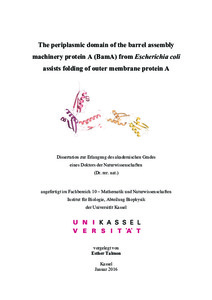| dc.date.accessioned | 2016-12-19T12:56:52Z | |
| dc.date.available | 2016-12-19T12:56:52Z | |
| dc.date.issued | 2016-12-19 | |
| dc.identifier.uri | urn:nbn:de:hebis:34-2016121951757 | |
| dc.identifier.uri | http://hdl.handle.net/123456789/2016121951757 | |
| dc.language.iso | eng | |
| dc.rights | Urheberrechtlich geschützt | |
| dc.rights.uri | https://rightsstatements.org/page/InC/1.0/ | |
| dc.subject | Escherichia coli | eng |
| dc.subject | Membanproteine | ger |
| dc.subject | BAM complex | eng |
| dc.subject.ddc | 570 | |
| dc.title | The periplasmic domain of the barrel assembly machinery protein A (BamA) from Escherichia coli assists folding of outer membrane protein A | eng |
| dc.type | Dissertation | |
| dcterms.abstract | The assembly of outer membranes of the cell wall of Gram-negative bacteria and of various organelles of eukaryotic cells requires the evolutionarily conserved β-barrel-assembly machinery (BAM) complex. This thesis describes the biochemical and biophysical properties of the periplasmic domain of the β-barrel assembly machinery protein A (PD-BamA) of the E. coli BAM complex, its effect on insertion and folding of the Outer membrane protein A (OmpA) into lipid bilayers and the identification of regions of PD-BamA that may be involved in protein-protein interactions. The secondary structure of PD-BamA in mixed lipid bilayers, analyzed by Circular dichroism (CD) spectroscopy, contained less β-sheet at an increased content of phosphatidylglycerol (PG) in the lipid membrane. This result showed membrane binding, albeit only in the presence of negatively charged lipids. Fluorescence spectroscopy demonstrated that PD-BamA only binds to lipid bilayers containing the negatively charged DOPG, confirming the results of CD spectroscopy. PD-BamA did not bind to zwitterionic but overall neutral lipid bilayers. PD-BamA bound to OmpA at a stoichiometry of 1:1. PD-BamA strongly facilitated insertion and folding of OmpA into lipid membranes. Kinetics of PD-BamA mediated folding of OmpA was well described by two parallel folding processes, a fast folding process and a slow folding process, differing by 2-3 orders of magnitude in their rate constants. The folding yields of OmpA depended on the concentration of lipid membranes and also on the lipid head groups. The presence of PD-BamA resulted in increased folding yields of OmpA in negatively charged DOPG, but PD-BamA did not affect the folding kinetics of OmpA into bilayers of zwitterionic but overall neutral lipids. The efficiency of folding and insertion of OmpA into lipid bilayers strongly depended on the ratio PD-BamA/OmpA and was optimal at equimolar concentrations of PD-BamA and OmpA. To examine complexes of unfolded OmpA with PD-BamA in more detail, site-directed spectroscopy was used to explore contact regions in both, PD-BamA and OmpA. Similarly, contact regions were also investigated for another protein complex formed by PD-BamA and the lipoprotein BamD. The obtained data suggest, that the site of interaction on PD-BamA for OmpA might be oriented towards the exterior environment away from the preceding POTRA domains, but that PD-BamA is oriented with its short α-helix α1 of POTRA domain 5 towards the C-terminal end of BamD. | eng |
| dcterms.accessRights | open access | |
| dcterms.creator | Talmon, Esther | |
| dc.contributor.corporatename | Kassel, Universität Kassel, Fachbereich 10 – Mathematik und Naturwissenschaften, Institut für Biologie, Abteilung Biophysik | |
| dc.contributor.referee | Kleinschmidt, Jörg H. (Prof. Dr.) | |
| dc.contributor.referee | Stengl, Monika (Prof. Dr.) | |
| dc.subject.swd | Escherichia coli | ger |
| dc.subject.swd | Membanproteine | ger |
| dc.date.examination | 2016-05-31 | |

